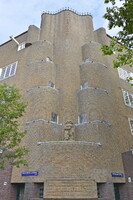Housing De Dageraad
Klerk, Michel de; Kramer, Pieter Lodewijk

Download1A2-N-A-CDD-C01_cp.jpg (688.9Kb)
Alternate file
Date
1919-1922Description
Building at east corner of Burgemeester Tellengenstraat (left) and Pieter Lodewijk Takstraat (right); sculpture by artist John Rädecker; De Klerk and Kramer designed the housing blocks for the socialist De Dageraad ("The Dawn") housing association in the neighborhood known as Nieuwe Pijp, designed by Berlage in 1917. These blocks, on the Pieter Lodewijk Takstraat, the Burgemeester Tellegenstraat, the Henriëtte Ronnerplein and Thérèse Schwartzeplein, have different, highly expressionistic façades, behind which are rather small but attractive, well-planned apartments. Built with a council subsidy, they satisfied all the imposed conditions; a maximum of four levels, staircases in direct contact with the open air, and the greatest percentage of space for the living rooms. The complex consists mainly of three- and four-room units which meant for its new tenants a considerable improvement in living standards. De Klerk's main contribution was the housing on two squares, Th. Schwartzeplein and H. Ronnerplein. The dwellings are assembled in groups separated by deep recesses in the roofline. He also designed the frontage along P.L. Takstraat (Kramer did the corner buildings). Kramer was responsible for the housing on Burg. Tellegenstraat, W. Passtoorsstraat and Talmastraat. Source: Architectureguide.nl [website]; http://www.architectureguide.nl (accessed 8/22/2015)
Type of Work
housing project; apartment houseSubject
architecture, City planning, Housing, Socialism, Amsterdam school, Twentieth century
Rights
Rights Statement
Licensed for educational and research use by the MIT community only